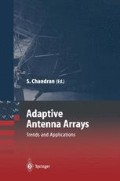Abstract
In the coherent CDMA systems with adaptive antenna arrays, two representative architectures for the spatial-temporal CDMA demodulator are demonstrated based on the way of weight vector multiplication, which are chip-level beamforming (CLBF) and symbol-level beamforming (SLBF). Depending on the architecture, implementational complexity differs about 1.5 ~ 2.5 times. Moreover, the performance variation due to the method of searcher beamforming and finite word-length (FWL) effects is tightly related to the architecture of the spatial-temporal demodulator. Performance comparison of various beamforming algorithms are also given for the cases of low and high data rate applications.
This work was supported by INHA University Research Grant (INHA-30362).
Access this chapter
Tax calculation will be finalised at checkout
Purchases are for personal use only
Preview
Unable to display preview. Download preview PDF.
References
G. Turin, “The effects of multipath and fading on the performance of direct sequence CDMA systems;” IEEE J. Select. Areas Commun., vol. 2, pp. 597–603, July 1984
K. S. Gilhousen, I. M. Jacobs, R. Padovani, A. J. Viterbi, L. A. Weaver, Jr. and C. E. Wheatley III, “On the capacity of a cellular CDMA systems;’ IEEE Trans. Veh. Tech., vol. 40, pp. 303–312, May 1991
L. M. A. Jalloul and J. M. Holtzman, “Performance analysis of DS/CDMA with non-coherent M-ary orthogonal modulation in multipath fading channels;’ IEEE J. Select. Areas Commun., vol. 12, pp. 862–870, June 1994
A. Jalali and P. Mermelstein, “Effect of diversity, power control, and bandwidth on the capacity of microcellular CDMA systems;’ IEEE J. Select. Areas Commun., vol. 12, pp. 952–961, June 1994
J. C. Liberti, Jr. and T. S. Rappaport, “Analytical results for capacity improvements in CDMA;’ IEEE Trans. Veh. Tech., vol. 43, pp. 680–690, Aug. 1994
L. C. Godara, “Applications of antenna arrays to mobile communications, Part I: Performance improvement, feasibility, and system considerations;’ Proc. IEEE, vol. 85, pp. 1029–1060, July 1997
L. C. Godara,“Applications of antenna arrays to mobile communications, Part II: Beam-forming and direction-of-arrival considerations;’ Proc. IEEE, vol. 85, pp. 1193–1245, Aug. 1997
K. H. Chang, E. S. Shin and M. G. Kyeong, “Design philosophy of adaptive antenna arrays in CDMA systems,” in Proc. ICSPAT, Sep. 1997, pp. 433–437
K. H. Chang, E. S. Shin, Y. O. Park and M. G. Kyeong, “Spatio-temporal processing in CDMA systems with adaptive antenna arrays;’ in Proc. MOMUC, Oct. 1997, pp. 209–212
K. H. Chang, R. Arnott, E.S. Shin, Y.O. Park and M.G. Kyeong, “A spatial-temporal receiver for CDMA systems;’ in Proc. IEEE DSP Workshop,Aug. 1998, #124
K. H. Chang, E. S. Shin, Y. O. Park and M. G. Kyeong, “MMSE 2-D RAKE receiver in CA3TS;’ in Proc. IEEE ISSATA, Sep. 1998, pp. 566–570
K. H. Chang, Y. G. Kang, E. S. Shin and H. R. Park,“CDMA beamforming algorithms for multimedia communications;’ in Proc. MOMUC, Oct. 1998, pp. 197–204
J. Ramos, M. D. Zoltowski and H. Liu, “A low-complexity space-time RAKE receiver for DS-CDMA communications;’ IEEE SP Letters, vol. 4, pp. 262–265, Sep. 1997
R. O. Schmidt, “A signal subspace approach to multiple-emitter location and spectral estimation:’ Ph.D. Dissertation, Stanford Univ., 1981
R. Roy and T. Kailath,“ESPRIT–Estimation of Signal Parameters via Rotational Invariance Techniques;’ IEEE Trans. ASSP, vol. 37, pp. 984–995, July 1989
H. Krim and M. Viberg,“Two decades of array signal processing research–The parametric approach;’ IEEE Signal Processing Magazine, pp. 67–94, July 1996
B. D. Van Veen and K. M. Buckley, “Beamforming: A versatile approach to spatial filtering;’ IEEE ASSP Magazine, pp. 4–24, April 1988
M. Barrett, R. Arnott, E Coromina, J. Fernandez and M. A. Lagunas,“Temporal reference beamforming for user acquisition in mobile satellite communication systems;’ pp. 22–34
J. Litva and T. KY. Lo, Digital Beamforming in Wireless Communications. Artech House, Boston, MA, Aug. 1996
S. Choi and T. Sarkar, “Adaptive antenna array utilizing the conjugate gradient method for multipath mobile communications;’ Signal Processing, vol. 29, pp. 319–333, 1992
D. N. Godard, “Self-recovering equalization and carrier tracking in a two-dimensional data communication system,” IEEE Trans. Commun., vol. 28, pp. 1867–1875, 1980
B. G. Agee, S. V. Schell and W. A. Gardner, “Spectral self-coherence restoral: A new approach to blind adaptive signal extraction using antenna arrays;’ Proc. IEEE, vol. 78, pp. 753–767, April 1990
A. J. van der Veen, M. C. Vanderveen and A. Paulraj, “Joint angle and delay estimation using shift-invariance techniques,” IEEE Trans. Signal Processing, vol. 46, pp. 405–418, Feb. 1998
K. H. Chang and H. R. Park,“Chip-level beamforming vs. symbol-level beamforming in coherent CDMA adaptive antenna array systems,” in Proc. IEEE /CC, June 1999, S40A-2
K. H. Chang, I. S. Sohn and K. S. Chang, “Chip-level 2-D RAKE receiver with symbol-level searcher beamforming,” in Proc. IEEE VTC Fall, Sep. 1999, pp. 924–928
H. K. Jwa, H. S. Oh and M. G. Kyeong, “Decision-directed chip-level beamforming in WCDMA antenna array system,” in Proc. IEEE VTC Spring, May 2002, pp. 322–326
J. J. Park, J. H. Lee and H. S. Oh, “Performance of chip-/symbol-level beamforming algorithm for WCDMA-TDD system,” in Proc. IEEE VTC Spring, May 2002, pp. 365–369.
A. F. Naguib and A. Paulraj, “Performance of cellular CDMA with M-ary orthogonal modulation and cell site antenna arrays,” IEEE J. Select. Areas Commun., vol. 14, pp. 1770–1783, Dec. 1996
S. Haykin, Adaptive Filter Theory. Prentice Hall, Upper Saddle River, NJ, 1996
R. A. Monzingo and T. W. Miller, Introduction to Adaptive Arrays. John Wiley & Sons, New York, NY, 1980
Author information
Authors and Affiliations
Editor information
Editors and Affiliations
Rights and permissions
Copyright information
© 2004 Springer-Verlag Berlin Heidelberg
About this chapter
Cite this chapter
Chang, K. (2004). Chip-level Beamforming and Symbol-level Beamforming in Coherent CDMA Adaptive Antenna Array Systems. In: Chandran, S. (eds) Adaptive Antenna Arrays. Signals and communication technology. Springer, Berlin, Heidelberg. https://doi.org/10.1007/978-3-662-05592-2_33
Download citation
DOI: https://doi.org/10.1007/978-3-662-05592-2_33
Publisher Name: Springer, Berlin, Heidelberg
Print ISBN: 978-3-642-05775-5
Online ISBN: 978-3-662-05592-2
eBook Packages: Springer Book Archive

